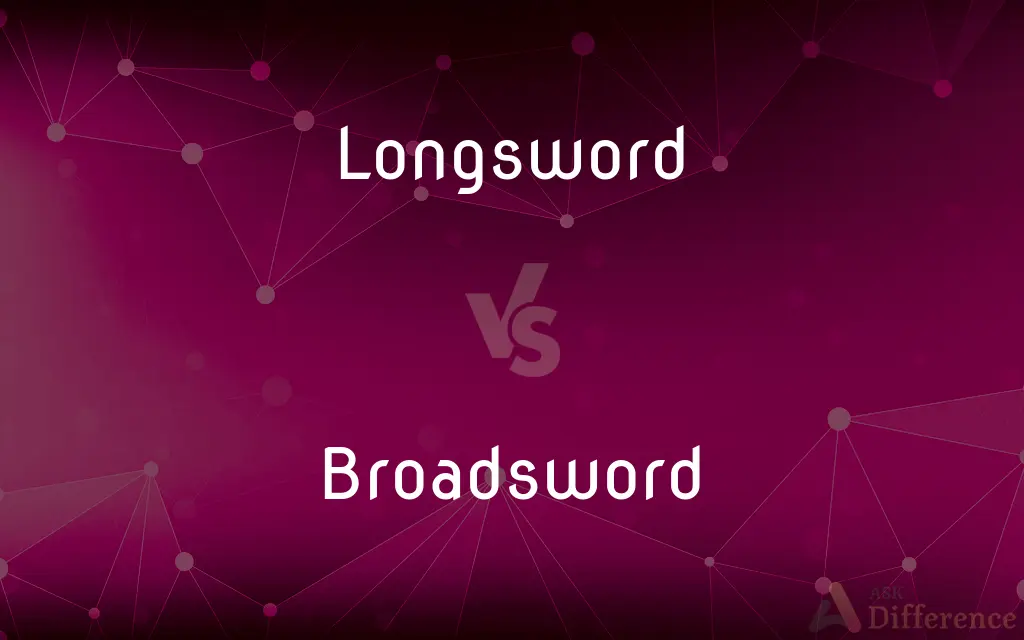Longsword vs. Broadsword — What's the Difference?
By Tayyaba Rehman & Urooj Arif — Updated on March 14, 2024
Longsword is a balanced, double-edged weapon for thrusting and cutting, used in medieval Europe. Broadsword refers to a wide, single-edged blade for slashing, popular in the Renaissance.

Difference Between Longsword and Broadsword
Table of Contents
ADVERTISEMENT
Key Differences
The longsword, characterized by its long, double-edged blade, was designed for reach, versatility in combat, and the ability to deliver both cuts and thrusts. In contrast, the broadsword typically features a wider, single-edged blade, emphasizing slashing attacks over thrusting, and was often used with one hand, allowing for a shield or another weapon in the off-hand.
While the longsword was a staple of medieval European warfare, employed effectively in both one-on-one combat and on the battlefield, the broadsword saw its prominence during the Renaissance, particularly in Scotland and England, where it became synonymous with military might and personal defense.
The longsword's design includes a cruciform hilt with a grip long enough to accommodate two hands, providing greater control and power in swings and thrusts. On the other hand, broadswords often had basket-hilt designs that protected the wielder's hand, offering a different balance between offense and defense.
Techniques for wielding a longsword are documented in numerous historical fencing manuals, showcasing a sophisticated system of guards, strikes, and counters. The broadsword, while also benefiting from a rich tradition of martial arts, typically emphasized simpler, more direct combat styles, suitable for the chaotic environments of battles and duels.
The longsword symbolized the knightly virtues of the medieval period, associated with chivalry, honor, and the art of war. The broadsword, meanwhile, became a symbol of the Scottish and English warriors' rugged practicality and effectiveness in close quarters combat.
ADVERTISEMENT
Comparison Chart
Era
Medieval Europe (Approx. 13th to 17th century)
Renaissance (Approx. 15th to 17th century)
Blade Type
Double-edged, for cutting and thrusting
Single-edged, primarily for slashing
Usage
Both hands typically for greater control and power
Mainly one-handed, allowing for use of shields or other weapons
Design Features
Cruciform hilt, long grip
Basket-hilt design for hand protection
Combat Style
Versatile; includes thrusts, cuts, and complex maneuvers
Focused on slashing, with simpler direct attacks
Historical Significance
Symbol of knightly virtues, chivalry
Associated with Scottish and English military tradition
Martial Arts Tradition
Detailed in fencing manuals, sophisticated system
Emphasizes practical, straightforward techniques
Compare with Definitions
Longsword
Known for its reach and versatility.
The longsword was effective both on horseback and on foot.
Broadsword
A broad. single-edged sword for slashing.
The broadsword was favored by Scottish clans for its cutting power.
Longsword
Symbolizes medieval chivalry.
The longsword often appears in tales of knights and their deeds.
Broadsword
Associated with the Renaissance period.
Broadswords were common among Renaissance soldiers and duelists.
Longsword
Used in a wide range of combat techniques.
Fencing manuals from the medieval period detail longsword fighting styles.
Broadsword
Often features a basket hilt for hand protection.
The intricate designs of broadsword hilts were both functional and decorative.
Longsword
A double-edged sword designed for two-handed use.
Medieval knights trained extensively with the longsword for combat.
Broadsword
Suited for one-handed combat.
Soldiers wielded the broadsword in one hand. often carrying a shield in the other.
Longsword
Integral to European martial arts.
Historical European martial arts (HEMA) enthusiasts frequently practice with longswords.
Broadsword
Reflects Scottish and English military traditions.
The broadsword holds a place of honor in military history. especially in Scotland and England.
Longsword
A longsword (also spelled as long sword or long-sword) is a type of European sword characterized as having a cruciform hilt with a grip for two-handed use (around 16 to 28 cm or 6 to 11 in), a straight double-edged blade of around 85 to 110 cm (33 to 43 in), and weighing approximately 1 to 1.5 kg (2 lb 3 oz to 3 lb 5 oz).The "longsword" type exists in a morphological continuum with the medieval knightly sword and the Renaissance-era Zweihänder. It was prevalent during the late medieval and Renaissance periods (approximately 1350 to 1550), with early and late use reaching into the 12th and 17th centuries.
Broadsword
A sword with a wide blade, used for cutting rather than thrusting.
Longsword
A sword with a long blade, especially one designed to be used with two hands.
Broadsword
A sword with a wide, usually two-edged blade that is designed for slashing rather than thrusting.
Longsword
Usually with capital initial. (An epithet of) William, third earl of Salisbury (1167–1226), the illegitimate son of King Henry II of England and Ida de Tosny, and his son, also named William (1209–50).
Broadsword
(history) A type of early modern sword that has a broad double-edged blade for cutting (as opposed to the more slender thrust-oriented rapier) and typically a basket hilt.
Longsword
Any type of sword that is comparatively long; depending on context, applied to swords of the Bronze Age, Migration period, Viking Age and Renaissance era.
Broadsword
A person armed with such a sword.
Longsword
A European sword with a long, straight double-edged blade, a cruciform hilt, and a grip for two-handed use; prevalent from the 14th to 16th centuries.
Broadsword
Syn of longsword
Broadsword
A flat, rectangular bread made from corn (maize) and beans by the Cherokee, traditionally by boiling rather than baking it.
Broadsword
A sword with a broad blade and a cutting edge; a claymore.
I heard the broadsword's deadly clang.
Broadsword
A sword with a broad blade and (usually) two cutting edges; used to cut rather than stab
Common Curiosities
Are these swords still used today?
They are mainly used in historical reenactments, martial arts training, and as ceremonial or decorative items.
Was the broadsword only used in Scotland and England?
While particularly associated with these regions, the broadsword style and similar weapons were used in various forms across Europe.
Can the longsword be used with one hand?
While primarily designed for two-handed use, skilled warriors could also wield the longsword with one hand in certain situations.
What is the significance of the hilt designs?
Hilt designs provided protection for the hand and affected the sword's balance and handling characteristics.
Could a broadsword effectively penetrate armor?
Broadswords were more suited to slashing and were less effective against heavy armor compared to the piercing capabilities of some longswords.
What distinguishes a longsword from a broadsword?
The main differences lie in their design; longswords have long, double-edged blades for two-handed use, while broadswords have broader, single-edged blades often used one-handed.
Which sword would have been better in battle?
It depends on the context of the battle; longswords offered greater versatility, while broadswords provided robust slashing capabilities and could be used with a shield.
Are longswords heavier than broadswords?
Not necessarily; weight depends on the specific design and materials, but longswords were balanced for two-handed use.
How did sword design evolve from the longsword to the broadsword?
Evolution in armor technology and combat tactics influenced the transition towards different sword types, including the broadsword's emphasis on slashing.
Did knights use broadswords?
Knights predominantly used longswords, but the term "knight" spans a wide historical period, and preferences in weapons evolved.
What role did these swords play in historical warfare?
They were versatile weapons for close combat, with the longsword being prominent in medieval battles and the broadsword in later skirmishes and duels.
What materials were these swords made from?
They were typically forged from steel, with variations in composition and technique over time and regions.
How are these swords preserved or displayed in modern times?
Museums, collectors, and enthusiasts preserve these swords, often displaying them as part of historical exhibitions or for educational purposes.
Is there a difference in the training required for these weapons?
Yes, each weapon has its own set of techniques and principles, reflecting their distinct designs and uses in combat.
Were these swords used by foot soldiers or cavalry?
Both were used by foot soldiers and cavalry, though the longsword's versatility was particularly valued by mounted knights.
Share Your Discovery

Previous Comparison
Travelator vs. Escalator
Next Comparison
Cordial vs. NiceAuthor Spotlight
Written by
Tayyaba RehmanTayyaba Rehman is a distinguished writer, currently serving as a primary contributor to askdifference.com. As a researcher in semantics and etymology, Tayyaba's passion for the complexity of languages and their distinctions has found a perfect home on the platform. Tayyaba delves into the intricacies of language, distinguishing between commonly confused words and phrases, thereby providing clarity for readers worldwide.
Co-written by
Urooj ArifUrooj is a skilled content writer at Ask Difference, known for her exceptional ability to simplify complex topics into engaging and informative content. With a passion for research and a flair for clear, concise writing, she consistently delivers articles that resonate with our diverse audience.
















































